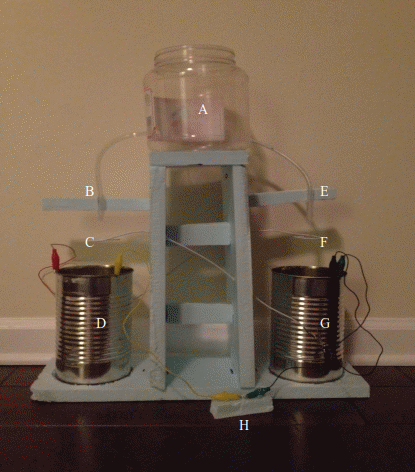The Lord Kelvin's Thunderstorm I Built
Published
Preface
This is a project that I did way back in 2012 when I was in high school; for an English class of all things. The teacher told us to read “a book” so that’s what I did. When we got to the project it was all about characters and plot lines. The book I read Homemade Lightning: Creative Experiments In Electricity by R. A. Ford. How was I supposed to know I needed to read a novel? Fortunately, I had a good teacher. They let me build one of the generators and write about it for my project. This is the result.
Lord Kelvin’s Thunderstorm

Lord Kelvin’s thunderstorm is a type of electrostatic generator using electrostatic inductance and positive feedback to generate a high voltage using falling water.
As influence generators go this is a pretty simple one. It is symmetrical down the center and on each side it has a dripper B a ring C and a can D. Both drippers are fed from a common reservoir A. The water streams they produce break into drips before they reach the rings. Each of the rings is connected to the opposite can. C to G and F to D. After the drips fall through the rings they land in their respective cans.
The way in which it does this is pretty simple. First we will suppose there is a slight negative voltage on one of the cans G and by connection the ring on the other side C, the small negative voltage will push away electrons from the tip of the dripper B causing it to become positively charged. As water flows out it breaks into drips cutting off its positive charge from the water supply, then it passes through the loop and lands in the can D giving it its entire charge. Then this positive charge goes up to the ring F on the other side and this ring does the same thing as the other except the charges are reversed. As the charges increase on the cans they induct even higher voltage in the drops and so the system develops positive feedback. After a while a spark will form in the spark gap discharging both cans.
The use for this type of generator is generally restricted to a mere oddity due to its low-voltage (as far as these generators are concerned), low power, and low efficiency. Still it is very cool to build and an interesting phenomenon can be observed. One may notice as the voltage reaches its peak value the water streams will not remain straight but instead the droplets will be pushed off to the side in random directions. This is due to the charged drops being attracted to their rings and repelled from their cans. This can be quite a problem for achieving high voltages as eventually the drops will simply not land in the cans. Also the polarity of the machine is completely random however one might overcome this by pre-charging one of the cans.
There are a few improvements I could have made to this generator but they would’ve taken a long time and I’m not really necessary. For one I could’ve used better dripping nozzles; you want a continuous stream of small drops but not a mist. Also the cans could be made so that they drain without discharging back into the reservoir so that I could run the generator continuously. Also painting on some insulation to the out side of the cans and the rings may have helped some.